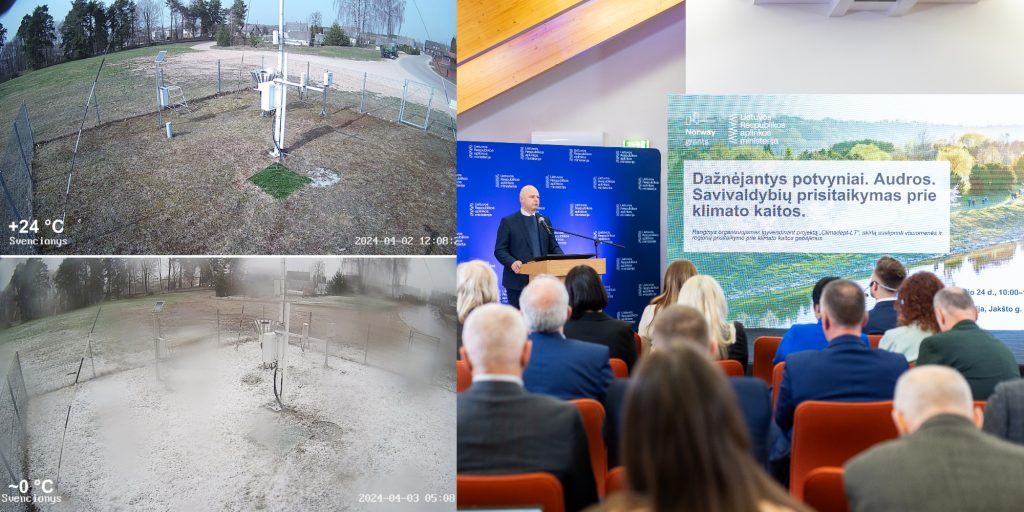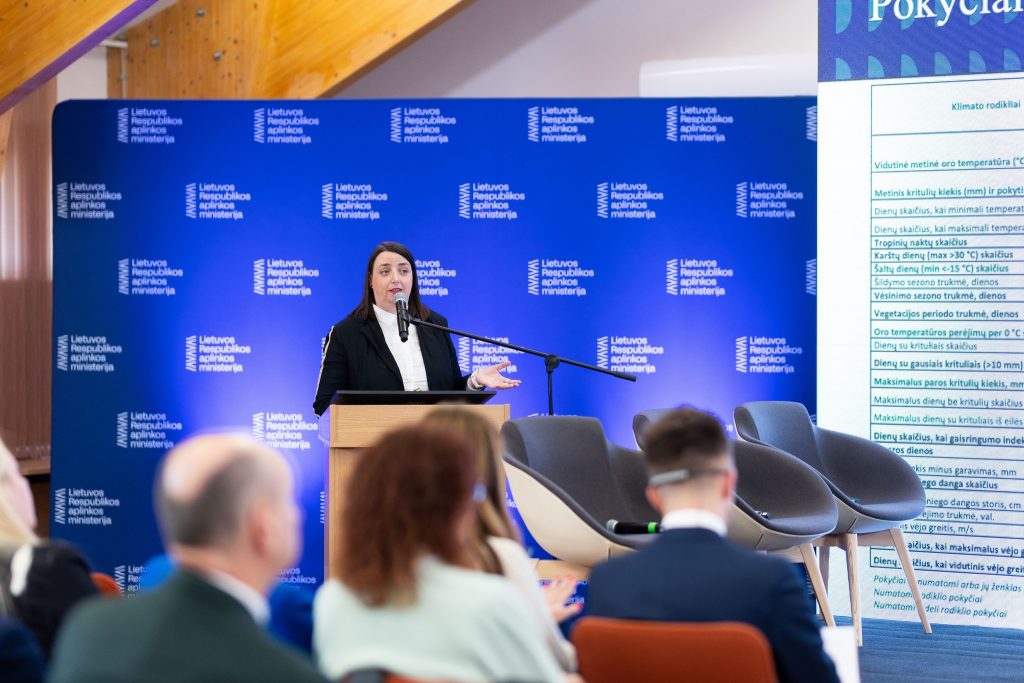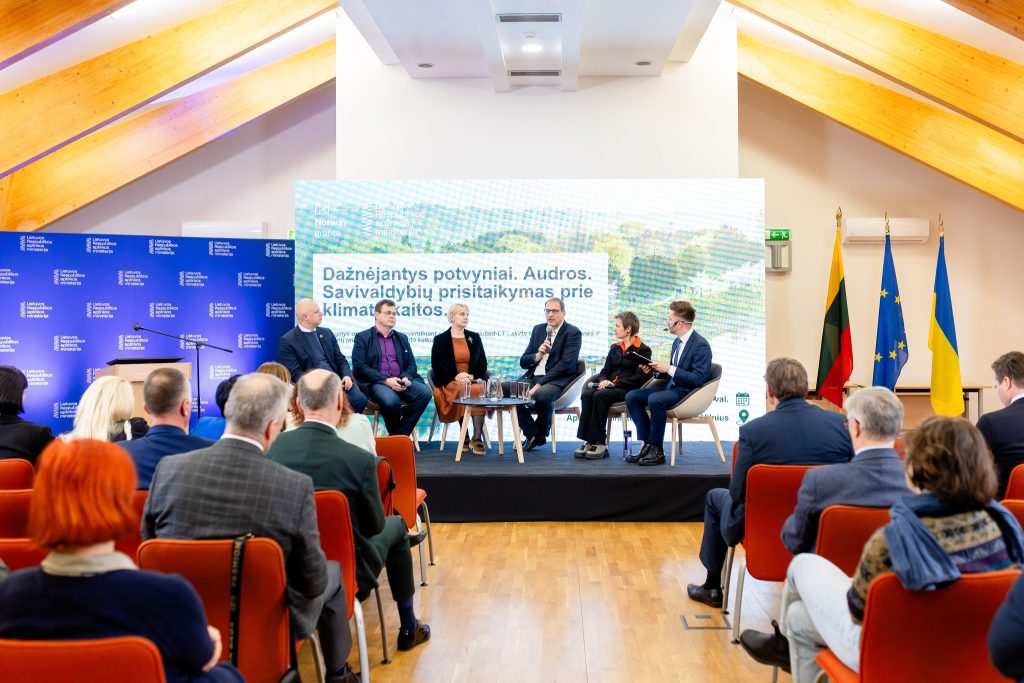2024-04-25 | This April’s rollercoaster of weather – a daily routine for the near future
By the end of the century, heatwaves and tropical nights are predicted to increase, the growing season will lengthen and cold days will decrease. Total annual precipitation is also projected to continue to increase from the current 684 mm to between 42 mm and 98 mm, especially in winter. Baltic Sea level rise will range from 22 cm to 35 cm.
These climate projections for the next century were presented this Wednesday at the Ministry of the Environment’s event “Increasing floods. Storms. Adaptation of municipalities to climate change”.

“This decade is likely to have been the warmest in 125 000 years. The global average temperature has risen by more than 1.5 °C in the last 12 months.This year’s climate fluctuations in Lithuania reflect trends in climate change. In April, we had both record high temperatures and snow. In some places, the monthly precipitation rate fell in a single snowfall. Municipalities had to decide whether to put sand spreaders on the streets or to turn the heating back on,” said Judita Liukaitytė-Kukienė, Senior Adviser to the Climate Policy Group at the Ministry of Environment.
“Today, we need to talk not only about mitigation but also about adaptation. Last year, floods in the coastal region and the collapse of sewage treatment plants caused losses of around €250 million. Yesterday, we saw how much snow there was in some places. We have already had ten heat records this year. This shows that there will be a crisis, and the question is whether we will be able to prepare for it, to protect the health of our people, our towns and cities, our nature, our roads, our energy sector, our agriculture. The flag of leadership must be waved by the local government, which will have to protect its citizens and focus on nature-based urban solutions,” said Simonas Gentvilas, Minister of the Environment.
According to Ms Liukaitytė-Kukienė, climate change is predicted to be responsible for 4 out of every 5 natural disasters and other global problems in the world over the next decade. In Lithuania, climate change is an integral part of the processes taking place in the globe’s climate system, and its effects are being felt in our country as well.
In Lithuania, the average annual temperature has risen by 2.3 °C between 1961 and 2022. It is projected to rise by another 1 to 3 degrees in the future. The number of hot days, when the maximum daily temperature reaches and exceeds 30 °C, has more than tripled, with an average of 5.8 days. The number of cold days, when the minimum daily air temperature drops to -20 °C and below, has almost halved, with an average of 10.5 days.
Annual precipitation increased by about 73 mm or 11% over the period, while the duration of sunshine increased by 7% or 127 hours.
All of the above forecasts are based on the results of the ClimAdapt-LT project in Lithuania and Norway.
“We need to think about how we are going to live our lives, how we are going to plan our daily activities so that the budgets of the state, municipalities and the population suffer as little damage as possible. The biggest changes are expected in winter, which will be much warmer, but we need to prepare for that too, because prolonged temperatures around zero are particularly damaging for roads, as it gets warmer and colder, and potholes form,” said J. Liukaitytė-Kukienė.

As average cold temperatures rise, people become less resilient to cold, which will increase the adverse health effects of cold. Although the number of cold days will decrease in winter, there will still be a need to change tyres and grit the streets. The number of heating days will decrease, but the thaws will be interspersed with cold snaps, as in April, when it was 29 degrees one week and 9 degrees the next, so heating systems need to be able to react flexibly to natural conditions.
There will also be a sharp rise in August temperatures and more heatwaves. We need to adapt our buildings to this. The southern region of Lithuania will be particularly affected by the heat, where temperatures will be high both day and night, and we will need to make sure that our buildings are cooled and air-conditioned so that people can rest.
There are also simple things that municipalities are already doing to help people adapt to the heat, such as installing fountains and water columns in towns, but the network should be expanded. Schools should be renovated with heat recovery systems so that the education process does not have to be interrupted in extreme temperatures.
Nature is also giving us signals: ticks that spread disease are increasingly attacking, pine forests and spruce forests are suffering from pests, and allergies are on the rise. Parks and forests are being devastated by the abundance of rainfall, especially when a month’s worth of rain falls in a day. Heavy rains are replaced by dry spells, for which we must also be prepared, as the risk of fires increases. Climate change impacts are associated with increased mortality and cardiovascular morbidity in the future, as well as increasing heat stress and thermal discomfort. The healthcare system also needs to prepare for this.

Municipalities need to prepare individual plans with concrete actions. Our municipalities, though small, are very different. The Municipal Vulnerability Study prepared by ClimAdapt-LT identifies Kaunas, Klaipėda, Panevėžys, Šiauliai and Vilnius as the most vulnerable municipalities in 2100.
Klaipėda City Municipality, as one of the most vulnerable municipalities to climate change, has a Climate Change Adaptation Plan, which has been developed under the ClimAdapt-LT project, funded by the European Economic Area – Norway Grants Programme 2014-2021. The project has also developed plans for the municipalities of Panevėžys, Vilnius and Utena, Tauragė, Ukmergė, Birštonas and Varėna.
To help municipalities predict future climate change and plan adaptation actions, the Ministry of the Environment has produced an interactive map and a lightbox to show how the climate will change in each Lithuanian municipality by 2100.
The board allows you to select optimistic or pessimistic climate change scenarios, time periods and forecast indicators to see the overall situation in Lithuania, and if you select a municipality of interest, you can see a summary of the forecast information based on the indicators for that territory of the country.
An interactive climate change map and a lightbox are available at www.klimatokaita.lt.
On 24 April, the conference “Increasing Floods. Storms. Municipal Adaptation to Climate Change.” Watch the video here.